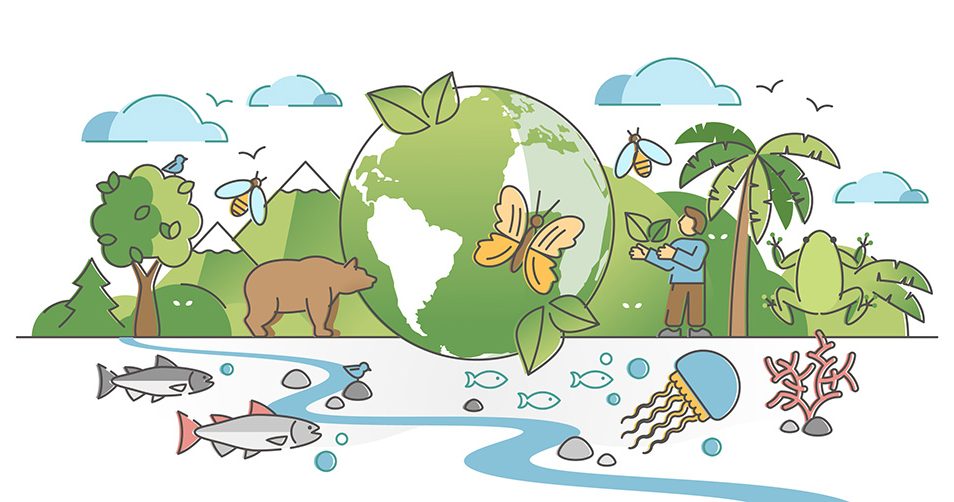Conserving Biodiversity in Japan and Germany
 © DWIH Tokyo/iStock.com/VectorMine
© DWIH Tokyo/iStock.com/VectorMine
August 25, 2021
[by Toru Kumagai]
The German Federal Ministry of Education and Research (BMBF) is involved in countless research projects, one of which expresses Germany’s emphasis on environmental protection very well: a project aimed at preserving biodiversity. The BMBF summarizes it as follows: “About one million species of plants and animals are threatened with extinction worldwide. The decrease in biodiversity is one of the biggest challenges facing the scientific, economic and political communities.”
Destruction of nature leads to rapid decline in biodiversity
In December 1993, the United Nations put into effect the Convention on Biological Diversity, which was signed by 168 countries and organizations. The purpose of the treaty is to protect plants and animals in danger of extinction and to preserve the global ecosystem. These countries and organizations have pledged to take measures to preserve the diversity of life on Earth, along with their habitats.
Biodiversity around the world is diminishing significantly due to the expansion of agricultural land, deforestation, and the heavy use of chemical fertilizers and pesticides.
According to the “Living Planet Report 2020” released by the World Wide Fund for Nature (WWF), the WWF surveyed about 21,000 species of mammals, birds, fish, amphibians, and reptiles and found that their numbers declined by 68% from 1970 to 2016. According to the WWF, gorillas in Congo, turtles in Costa Rica, and sturgeon in China are particularly endangered. In Germany, the numbers of two bird species – the Rebhuhn (European partridge) and the Kiebitz (taggerel) – have plummeted.
Since the beginning of the 20th century, German environmental groups and the media have frequently reported on the declines in insect and bird species that are occurring around the world.
For example, Tagesschau, a news program of the German public broadcaster ARD, reported in January 2020 that “according to a report published in 2018 by the University of Sydney, numbers are declining in 41 percent of insects in the region around Sydney, and a third are threatened with extinction. According to a research report on insects released by the German environmental group BUND, the number of bees is declining in 41% of the 561 species found in Germany,” the report said.
Since bees play an important role in carrying plant pollen, a decline in bee numbers will have a significant negative impact on crop yields.
BMBF Conducts Research Project on Biodiversity
To implement the UN conventions domestically, the German Federal Government approved the “National Biodiversity Strategy” in 2007. This national strategy included about 340 measures, for example designating areas with rare animal species as diversity hotspots and protecting them from development.
In February 2019, the BMBF launched a project called the “Research Initiative for Biodiversity Conservation”. The initiative has three goals.
1) To develop new technologies and methods to accurately assess the current status of biodiversity.
2) To systematically understand the causes, current status, and impacts of biodiversity loss.
3) To propose measures to halt the decline of biodiversity.
The BMBF started this project because the mechanism by which human activities (such as agriculture) reduce biodiversity is not yet fully understood. For example, it is speculated that pesticides used in agriculture are partly responsible for the decline in the number of bees and other insects, but the mechanism has not been proven through scientific research. Without collecting concrete data and scientifically backing up the process of biodiversity decline, the government will not be able to come up with concrete measures.
It is not easy to estimate the number of plants, animals, and insects. So far, the scientific community has recorded about 2.16 million species of plants, animals, and insects in the world, about 1 million of which are insects. However, there are still many insects that have not yet been discovered, and it is estimated that the number of these insects exceeds the number of insect species that have been confirmed so far. In other words, we humans do not even have an accurate grasp of the current state of biodiversity.
Therefore, the BMBF will first estimate the number and types of plants, animals, and insects in Germany using the latest methods, and then determine how much their numbers have been decreasing and over what period of time. The BMBF will use the data to determine why the numbers are declining, and then propose measures to the government.
Using AI for Biodiversity Conservation
The BMBF is proposing to use artificial intelligence (AI) in efforts to conserve biodiversity. Farmers need to protect their crops from pests and weeds to optimize yields, but to maintain biodiversity, they must avoid the use of pesticides and herbicides.
The BMBF is working with Professor Enno Barth, who is conducting research at the University of Hohenheim on the topic of “Agriculture 4.0 – How to protect crops without chemicals,” on a project about improving efficiency through AI in agriculture.
For example, AI will enable agricultural machinery to automatically distinguish between weeds that are harmful to crops and those that are not, and to cut only the harmful weeds. The BMBF has invested 40 million euros (about 5.2 billion Japanese yen) in projects to study such “future agricultural management”.
The Japanese government also places importance on the conservation of biodiversity, and in 2012, the Cabinet approved the National Biodiversity Strategy 2012-2020. This national strategy includes about 700 specific measures and sets 50 numerical targets.
From my perspective as a Japanese living in Germany, I feel that the Japanese media reports much less on biodiversity than in Germany. Here, there is a lot of news about the decline in the number of plants, animals, and insects, and citizens have a strong interest in it. In order to increase the public’s interest in biodiversity in Japan, I think the media needs to increase its coverage.
Click here to read other articles from the series “Toru Kumagai’s report on R&D trends in Germany”.

About Toru Kumagai
Born in Tokyo in 1959, Kumagai graduated from the Department of Political Science and Economics at Waseda University in 1982 and joined Japan Broadcasting Corporation (NHK), where he gained a wealth of experience in domestic reporting and overseas assignments. After NHK, he has lived and worked as a journalist in Munich, Germany, since 1990. He has published more than 20 books on Germany and Germany-Japan relations, as well as been to numerous media outlets to report on the situation in Germany.
